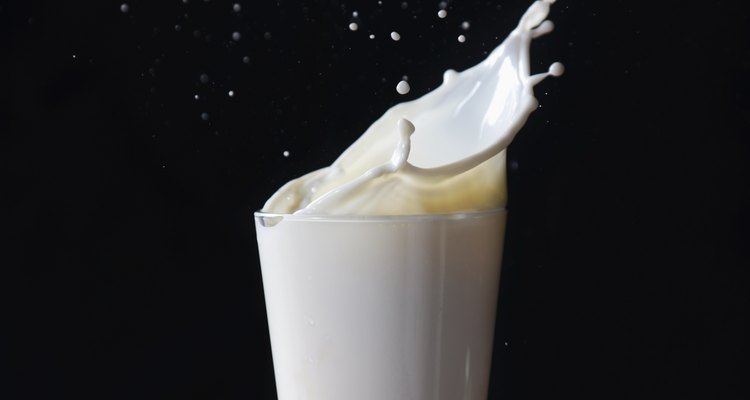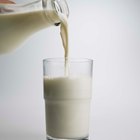
View Stock/View Stock/Getty Images
Bacteria have the ability to reproduce rapidly, allowing them to evolve and adapt to their environment quickly. Because of the speed with which they evolve, strains of bacteria can grow in extreme heat, extreme cold, acidic or alkaline environments, radioactive surroundings or in the presence of human toxins. Whatever environment they grow in, however, they need specific nutrients to support their growth. Milk contains these nutrients and provides a good medium for bacterial growth.
Water
The most fundamental nutrient bacteria require is water. Without water, no life form can survive, even if other nutrients are in abundance -- and this fact provides the basis for dehydration as a means to preserve food. Although bacteria can survive the resting spore stage of their life cycle with no water, they cannot metabolize nutrients or grow during this waterless phase of life. Fluid milk contains nearly 90 percent water by weight, according to the U.S. Department of Agriculture National Nutrient Database, providing bacteria the moisture they need for growth.
Sugar
In addition to water, bacteria require a fuel source to supply energy to power the growth process. Depending on the strain of bacteria, they can derive energy from sunlight, from organic molecules such as carbohydrates or from inorganic molecules, including carbon monoxide. Milk is rich in a sugar called lactose, a simple carbohydrate composed of a glucose molecule joined to a galactose molecule. Bacteria can metabolize milk sugar to produce the energy necessary for reproduction.
Protein
Milk contains a significant amount of protein, a nutrient made of nitrogen-rich amino acids. Bacteria require nitrogen to synthesize new proteins as they increase their population during growth. The protein in milk also provides a source of carbon the bacteria can use, in addition to lactose, as a fuel source.
Minerals
Bacteria need a variety of minerals for optimal growth, and milk supplies them. Milk, for example, contains ample calcium, a mineral required for bacterial function. Milk also offers phosphorous, potassium and sodium to help bacteria increase in number.
Considerations
Pasteurized milk in an unopened container has few or no bacteria growing in it. The milk may become contaminated once it is open, however, particularly if you allow a part of your body to touch the inside of the container. For this reason, avoid drinking milk directly from the carton or jug to prolong its shelf life. Keeping the milk cold also helps retard bacterial growth. Raw milk does not undergo the pasteurization process to kill off potentially pathogenic bacteria, and therefore may pose the risk of food poisoning. Because milk provides such a nutritious environment for bacteria to grow, pathogenic organisms can multiply rapidly in this medium.
Related Articles

What Type of Microorganism Is Used to ...

How Long Can Milk Stay Unrefrigerated?

How to Purchase Milk Crates

Difference Between Fermented Milk & ...

Whole Milk Vs. Lactaid Milk

Does Cooking Raw Milk Pasteurize It?

Calories in Gelato Vs. Ice Cream

Why Does Milk Freeze in the ...

Can I Dilute Whipping Cream to Sub Milk?

Can You Drink Milk That Expires the ...

What Does Rennet Do in Ice Cream?

How Does Flash Pasteurization Work?

What Happens if You Whip Condensed Milk?

A List of Foods Containing Microbes

Milk Protein for Skin Care

How to Substitute Dry Milk for ...
The Difference Between ...

How to Make Kava Tea Bags Effective

What Good Bacteria Is in Cheese?

Advantages of Vermicompost
References
Writer Bio
A writer since 1985, Jan Annigan is published in "Plant Physiology," "Proceedings of the National Academy of Sciences," "Journal of Biological Chemistry" and on various websites. She holds a sports medicine and human performance certificate from the University of Washington, as well as a Bachelor of Science in animal sciences from Purdue University.
Photo Credits
View Stock/View Stock/Getty Images